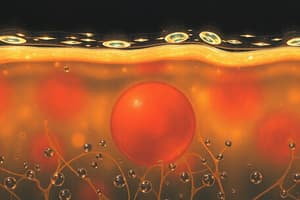Podcast
Questions and Answers
Which type of cell is specialised to absorb water from the soil?
Which type of cell is specialised to absorb water from the soil?
- Root hair (correct)
- Guard cell
- Companion cell
- Nerve cell
How is a short diffusion pathway into the bloodstream ensured?
How is a short diffusion pathway into the bloodstream ensured?
- the blood vessels are very narrow
- the blood vessels are very short
- the blood vessel walls are one cell thick (correct)
- the blood vessels are folded to increase surface area
What is diffusion?
What is diffusion?
- movement of particles from a region of high concentration to a region of low concentration, up a concentration gradient
- movement of particles from a region of high concentration to a region of low concentration, down a concentration gradient (correct)
- movement of particles from a region of low concentration to a region of high concentration, up a concentration gradient
- movement of particles from a region of low concentration to a region of high concentration, down a concentration gradient
How does oxygen move into the blood from the lungs?
How does oxygen move into the blood from the lungs?
Which of the following are potential hazards when carrying out the investigation of
osmosis using potatoes?
Which of the following are potential hazards when carrying out the investigation of osmosis using potatoes?
How does glucose move from the intestine into the bloodstream?
How does glucose move from the intestine into the bloodstream?
What does ‘semi-permeable’ mean, about a cell membrane?
What does ‘semi-permeable’ mean, about a cell membrane?
How does carbon dioxide move from the blood into the lungs?
How does carbon dioxide move from the blood into the lungs?
When investigating osmosis with potatoes, the change in mass is measured. What type
of variable is this?
When investigating osmosis with potatoes, the change in mass is measured. What type of variable is this?
What is osmosis?
What is osmosis?
Which method of transport requires energy from respiration?
Which method of transport requires energy from respiration?
Which is not a way of increasing the effectiveness of an exchange surface?
Which is not a way of increasing the effectiveness of an exchange surface?
How does water move into the roots of a plant?
How does water move into the roots of a plant?
What is active transport?
What is active transport?
Flashcards are hidden until you start studying
Study Notes
Specialized Cells and Transport
- Root hair cells are specialized to absorb water from the soil.
Diffusion and Osmosis
- Diffusion is the movement of particles from an area of higher concentration to an area of lower concentration until they are evenly distributed.
- Osmosis is the movement of water molecules from an area of higher concentration to an area of lower concentration through a semi-permeable membrane.
Cellular Transport
- Glucose moves from the intestine into the bloodstream through facilitated diffusion.
- Oxygen moves from the lungs into the blood through diffusion.
- Carbon dioxide moves from the blood into the lungs through diffusion.
- Active transport requires energy from respiration and is used to move molecules against their concentration gradient.
Investigating Osmosis
- Potential hazards when investigating osmosis using potatoes include contamination, inaccurate measurements, and inconsistent conditions.
- The change in mass measured during an osmosis investigation is a dependent variable.
Cell Membranes
- A semi-permeable membrane allows certain molecules to pass through while restricting others.
- Increasing the effectiveness of an exchange surface can be achieved by increasing the surface area, increasing the difference in concentration, and decreasing the thickness of the exchange surface.
Studying That Suits You
Use AI to generate personalized quizzes and flashcards to suit your learning preferences.




